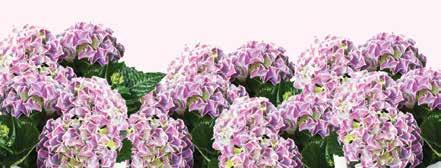
6 minute read
Plants on Your Plate–Rhubarb
This month’s plant is another example that begs the question ‘is it a vegetable or fruit’? Botanically speaking, rhubarb is a considered a vegetable, though it is more commonly used as a fruit in culinary preparations such as desserts or sweet spreads – with a fair amount of sugar added. To add to the confusion, in 1947 the U.S. Customs court in Buffalo, N.Y., legally classified rhubarb as fruit.
Though the origin of rhubarb is uncertain, it was commonly used in Asia over 2,000 years ago for its medicinal qualities. It was not until the 18th century that rhubarb was grown for culinary purposes in Britain and America. Rhubarb is a perennial plant in the Polygonaceae family, more commonly known as buckwheat. Rhubarb leaves contain a toxic compound that acts as a natural insecticide. This is the reason that the leaves are not fit for human consumption and only the rhubarb stalk is edible. Rhubarb ranges in color from light green to deep red depending on the variety, with a texture that is resemblant of celery. Typically, the deeper red a rhubarb stalk is, the less tart it will be.
Rhubarb is a nutrition powerhouse, with over 40 nutrient compounds present. A 1 cup serving provides about 25% of the daily value of Vitamin K, as well as Vitamins A and C, potassium, and dietary fiber, with under 30 calories. The high level of vitamin K should be considered by anyone on blood thinners, as it can intensify the effects of the medication. Beyond the vitamins and minerals, numerous phytochemicals provide additional health benefits including anti-inflammation and aiding in the prevention of cardiovascular disease and cancer. Rhubarb also contains about 15% of the daily value of calcium, however not in a form that is readily absorbed by the body. Calcium oxalate, the form found in rhubarb, may lead to the buildup of oxalate crystals in different organs, including the kidneys, which can increase risk of kidney stones.
Rhubarb’s high acidity, which is atypical for vegetables, is mostly due to malic acid. Malic acid is one of the most abundant acids in plants and contributes to the sour taste of many fruits and vegetables. For this reason, rhubarb can be safely processed as a high acid food using a boiling water bath process, as opposed to the pressure canned process required for most vegetables.
Rhubarb’s tart flavor requires a sweet helper and strawberries are a popular choice (and a personal favorite of mine) but the use of blueberries in the recipe below results in an exquisite blend of colors, flavors, and textures.
Help us evaluate our mass media efforts. Scan this code to tell what you’ve learned from this article. Thank you!
Rhubarb & Blueberry Crisp
MAKES 9 SERVINGS
INGREDIENTS Topping 1/4 cup packed brown sugar 1/2 cup all-purpose flour 1/2 cup old fashioned rolled oats 2 tablespoons ground flax seed 1/4 cup margarine or butter, melted
Fruit Filling 3 cups chopped rhubarb 3 cups blueberries 2 tablespoons cornstarch 1/2 cup sugar 1 teaspoon cinnamon 1 cup 100% apple juice 1 teaspoon vanilla
DIRECTIONS
Wash hands with soap and water.
Preheat oven to 350 degrees F.
In a medium bowl, stir together brown sugar, flour, oats, and flax seed. Mix in the margarine or butter and set aside.
Spread the rhubarb and blueberries in an 8x8-inch baking dish and set aside.
In a medium saucepan, mix cornstarch, sugar, and cinnamon until combined. Stir in the juice and cook over medium heat, stirring all the time, until the mixture has thickened. Turn off the heat.
Stir in vanilla and pour the mixture over the rhubarb and blueberries.
Crumble oat mixture on top of the fruit.
Bake for 45 minutes or until topping is browned and fruit is bubbling at edges. Serve warm or cold.
NUTRITION INFORMATION Calories: 185, Total Fat: 6.7g, Saturated Fat: .9g, Sodium: 65mg, Carbohydrates: 31g, Fiber: 3.5g, Protein: 2.5g
Recipe adapted from MyPlate Kitchen, analyzed by verywellfit.com.
DENISE SULLIVAN Nutrition Ninja
Denise Sullivan (@MUExtJacksonCo) is a Nutrition and Health Education Specialist for MU Extension in Jackson County. For research based nutrition and food safety information and programs, call 816-4825850 or visit https://extension2.missouri.edu/.tasty side dish for a late-summer picnic.
EARTH RIGHT products help you beat the heat. Our conditioner is in all of the plant products. This helps wick water, keeping plants cooler. For bigger roots & lots of blooms use Mushroom Stuff™ & Sure Bloom™ on turf or in gardens keeps roots from burning & soil conditioned.
Natural products that work!

Covers 20K sq ft.
Visit the Laura Conyers Smith Rose Garden & see Earth Right products at work! Covers 10K sq ft.
Often Copied NEVER DUPLICATED Accept only Earth Right Products for the health & beauty of your lawn & garden.®
Contact Tobin Lawn 816-765-5565, or Big Green Turf Management (816) 600-4936 to have our products applied for you.
Join our Loyalty Program







and become instantly eligible for giveaways, discounts and more






Scan the QR Code to sign up for free Kansas City
(Watt’s Mill) 1225 W 103rd Street Kansas City, MO 64114 (816) 216-6917 Store Hours Mon - Sat: 9am - 8pm Sun: 9am - 4pm
Lee’s Summit
(Deerbrook Plaza) 1201 NE Rice Road Lee’s Summit, MO 64086 (816) 600-2300 Store Hours Mon - Sat: 9am - 8pm Sun: 9am - 4pm
@yrroundgarden www.year-roundgarden.com
Live Life in Full Bloom Garden Symposium
Hosted by the Leavenworth County Master Gardeners
Saturday, September 17
8:30 a.m. – 4:00 p.m.
Cost is $45.00 per person. Box Lunch included. Riverfront Community Center, 123 Esplanade, Leavenworth, KS
Tickets on sale June 1 to August 31. Download and print a ticket to mail in: https://www.leavenworth.k-state.edu/lawn-garden/ master-gardeners/. Payments accepted: check, Visa or Mastercard. Purchase tickets by contacting Leavenworthmastergardeners @yahoo.com or calling the K-State Research and Extension Leavenworth County office at 913-364-5700.
Keynote Speaker: Kelly Norris
New Naturalism: Designing and Planting a Resilient, Ecologically Vibrant Home Garden
Kelly is one of the leading horticulturists of his generation. An award-winning author and Plantsman, Kelly’s work in gardens has been featured in the New York Times, Organic Gardening, Better Homes and Garden, Martha Stewart’s Living, Fine Gardening and Garden Design.
Afternoon Speakers

Mike Yoder/Lawrence Journal-World

Crystal Miles
Selecting Trees and Shrubs For Urban Living
Crystal is a 40 plus year Horticulturist and certified Arborist with design and maintenance experience in private, commercial and public landscaping.
Jonah Nelson
Fall Container Design
Jonah is the 3rd generation owner and store manager of Family Tree Nursery. He has a degree in Horticulture with an emphasis in landscape design.
For more information, contact Mikey Stafford at 913-426-3794 and Anne Rielly at 913-683-4646.









